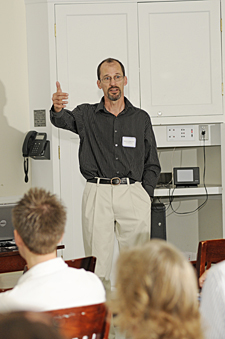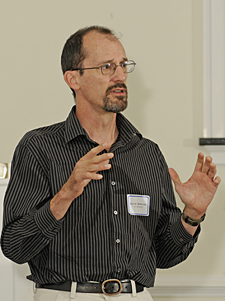

- Rozovsky wins prestigious NSF Early Career Award
- UD students meet alumni, experience 'closing bell' at NYSE
- Newark Police seek assistance in identifying suspects in robbery
- Rivlin says bipartisan budget action, stronger budget rules key to reversing debt
- Stink bugs shouldn't pose problem until late summer
- Gao to honor Placido Domingo in Washington performance
- Adopt-A-Highway project keeps Lewes road clean
- WVUD's Radiothon fundraiser runs April 1-10
- W.D. Snodgrass Symposium to honor Pulitzer winner
- New guide helps cancer patients manage symptoms
- UD in the News, March 25, 2011
- For the Record, March 25, 2011
- Public opinion expert discusses world views of U.S. in Global Agenda series
- Congressional delegation, dean laud Center for Community Research and Service program
- Center for Political Communication sets symposium on politics, entertainment
- Students work to raise funds, awareness of domestic violence
- Equestrian team wins regional championship in Western riding
- Markell, Harker stress importance of agriculture to Delaware's economy
- Carol A. Ammon MBA Case Competition winners announced
- Prof presents blood-clotting studies at Gordon Research Conference
- Sexual Assault Awareness Month events, programs announced
- Stay connected with Sea Grant, CEOE e-newsletter
- A message to UD regarding the tragedy in Japan
- More News >>
- March 31-May 14: REP stages Neil Simon's 'The Good Doctor'
- April 2: Newark plans annual 'wine and dine'
- April 5: Expert perspective on U.S. health care
- April 5: Comedian Ace Guillen to visit Scrounge
- April 6, May 4: School of Nursing sponsors research lecture series
- April 6-May 4: Confucius Institute presents Chinese Film Series on Wednesdays
- April 6: IPCC's Pachauri to discuss sustainable development in DENIN Dialogue Series
- April 7: 'WVUDstock' radiothon concert announced
- April 8: English Language Institute presents 'Arts in Translation'
- April 9: Green and Healthy Living Expo planned at The Bob
- April 9: Center for Political Communication to host Onion editor
- April 10: Alumni Easter Egg-stravaganza planned
- April 11: CDS session to focus on visual assistive technologies
- April 12: T.J. Stiles to speak at UDLA annual dinner
- April 15, 16: Annual UD push lawnmower tune-up scheduled
- April 15, 16: Master Players series presents iMusic 4, China Magpie
- April 15, 16: Delaware Symphony, UD chorus to perform Mahler work
- April 18: Former NFL Coach Bill Cowher featured in UD Speaks
- April 21-24: Sesame Street Live brings Elmo and friends to The Bob
- April 30: Save the date for Ag Day 2011 at UD
- April 30: Symposium to consider 'Frontiers at the Chemistry-Biology Interface'
- April 30-May 1: Relay for Life set at Delaware Field House
- May 4: Delaware Membrane Protein Symposium announced
- May 5: Northwestern University's Leon Keer to deliver Kerr lecture
- May 7: Women's volleyball team to host second annual Spring Fling
- Through May 3: SPPA announces speakers for 10th annual lecture series
- Through May 4: Global Agenda sees U.S. through others' eyes; World Bank president to speak
- Through May 4: 'Research on Race, Ethnicity, Culture' topic of series
- Through May 9: Black American Studies announces lecture series
- Through May 11: 'Challenges in Jewish Culture' lecture series announced
- Through May 11: Area Studies research featured in speaker series
- Through June 5: 'Andy Warhol: Behind the Camera' on view in Old College Gallery
- Through July 15: 'Bodyscapes' on view at Mechanical Hall Gallery
- More What's Happening >>
- UD calendar >>
- Middle States evaluation team on campus April 5
- Phipps named HR Liaison of the Quarter
- Senior wins iPad for participating in assessment study
- April 19: Procurement Services schedules information sessions
- UD Bookstore announces spring break hours
- HealthyU Wellness Program encourages employees to 'Step into Spring'
- April 8-29: Faculty roundtable series considers student engagement
- GRE is changing; learn more at April 15 info session
- April 30: UD Evening with Blue Rocks set for employees
- Morris Library to be open 24/7 during final exams
- More Campus FYI >>
11:33 a.m., Sept. 3, 2008----David P. Anderson, the pioneer of the volunteer computing paradigm and Berkeley Open Infrastructure for Network Computing (BOINC) of the University of California at Berkeley, spoke at the first-ever East Coast meeting of BOINC on Friday, Aug. 29, in the University of Delaware's Gore Hall.
BOINC itself is a managing program that allows an individual's computer to donate its spare number-crunching power to research when it is idle. It is a volunteer computer project, and Anderson described the idea of volunteer computing as a program that “is designed to make it possible for people who own PCs to donate part of the power of their PC to a scientific research project.”
Anderson spoke about the importance of BOINC and other volunteer computing projects. “Essentially, every area of science has been revolutionized by computing, and the more computing power that they have, the more science they can do,” Anderson said.
BOINC can be used on a variety of different research programs, and Anderson said, “If you look around at the applications that people are running using BOINC, they pretty much span the gamut of computational science. There's a big cluster of applications in computational biology and bio-medicine, people doing protein-folding and protein-structure prediction,” as well as applications such as climate prediction, gravitational wave detection and distributed seismography.
The cost of running BOINC is also a big help to scientists because where some number crunching devices cost in the hundreds of thousands and even in the millions of dollars, running 10 BOINC projects is estimated to cost only $2,000.
Anderson was introduced by Michela Taufer, a UD assistant professor in computer and information sciences, who organized the meeting and has firsthand knowledge of BOINC, having run the first-ever BOINC project titled “Predictor at Home” in 2004.
“Michela was an adopter at the point where BOINC really had more bugs than features, but somehow she got things working,” Anderson joked.
Anderson concluded his remarks by explaining that in order for volunteer computing projects like BOINC to grow, projects must be created at higher organizational levels, specifically, the university level.
“To me the most interesting level to look at is the University campus. The idea that a university, like the University of Delaware, could create a volunteer computing project that would serve all of the scientists at that university and would run on the university's PCs, would be marketed to the students and to alumni, it should pretty much be a slam dunk to get these students and alumni to support the research of their alma mater by running a simple program on their PC.”
For more information about BOINC, visit [http://boinc.berkeley.edu].
Article by Adam Thomas
Photo by Duane Perry


